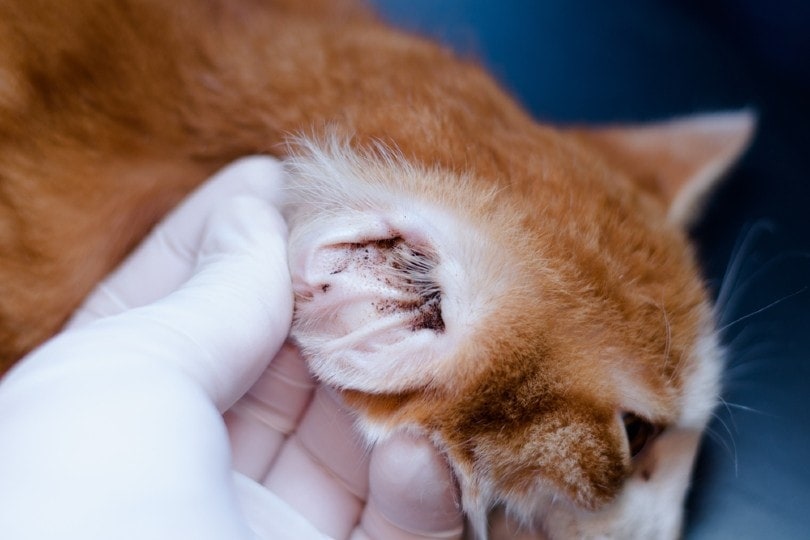How to Tell if Your Cat Has Ear Mites in 4 Easy Steps!

Updated on

Ear mites, or otodectes cynotis, are tiny parasites that are usually found in the ear canals or skin surfaces of cats, dogs, ferrets, and rabbits. These surface mites feed on ear wax and skin oils.
They are barely visible to the human eye, appearing as tiny, white specks that are difficult to recognize without a microscope. Ear mites are the second most common external parasite that is found on pets, second only to fleas. In this article, we’ll help you quickly understand if your feline is suffering from the particular itch that comes from ear mites and how to get rid of them quickly.
How Do Cats Get Ear Mites?
Ear mites are highly contagious and can be passed easily from one infected animal to another, as they will travel between the animals. Outdoor cats are at higher risk of contracting ear mites due to their exposure, but even indoor cats can be susceptible to these parasites.

Their eggs are laid in the ear and take four days to hatch. Once hatched, it takes approximately three weeks to reach adulthood. Adult ear mites will live for about 2 months and will reproduce constantly during their lifetime. While it is easy to get an ear mite infestation, it is also easy to treat. Let us take a look at how to tell if your cat has ear mites and what you can do about it.
Step-by-Step Guide to Finding Out if Your Cat Has Ear Mites
1. Know the Risk Factors

Knowing the risk factors associated with ear mites will help you in the process of determining whether your cat has fallen victim to these little parasites. Especially since ear mites can mimic other medical issues such as yeast and bacterial infections and allergies.
If your cat lives outdoors or spends some of its time outdoors, the risk of ear mites is much higher. You never know what they are being exposed to when they are venturing outdoors and since ear mites are very contagious, outdoor kitties are naturally more susceptible.
For indoor cats, ear mites can make their way into the home on another animal that spends time outside. In addition, boarding facilities have been known to pass ear mites but this is rarer, as reputable businesses make it a point to check.
2. Know the Signs
Knowing the symptoms of ear mites and keeping an eye out for them is the next step in how to tell if your cat has ear mites.
- Scratching/Pawing at Ears: The irritation from the ear mites will cause your cat to scratch and paw at the ears. These little mites are quite a nuisance that will cause irritation and discomfort.
- Head-Shaking: Head shaking is another indication of ear mites. The discomfort within the ear will cause your cat to go to any length to make that feeling go away. Itchy, uncomfortable ears that are full of debris will lead to head shaking along with pawing and scratching.
- Hair Loss: Due to the constant scratching and pawing, you may notice that your cat is experiencing hair loss around the ears and head. The hair loss may or may not be accompanied by inflammation and wounds from the scratching.
- Dark Otic Debris: With an ear mite infestation, you may notice some dark otic debris in your cat’s ears. The debris will likely appear dark reddish to dark brown and crusty, like coffee grounds. A waxier dark debris could also be observed due to the increase in ear wax.
- Ear Inflammation: Inflammation in and around the ears is common. Once the mites begin to cause irritation to the point of constant scratching and pawing of the ears, they will quickly become inflamed.
- Skin Lesions/Scabs: You may notice some skin lesions or scabbing around the ears once your cat has been excessively scratching their ears and head. It is important to contact your veterinarian when you notice the scratching and pawing so early treatment can prevent worsening symptoms associated with ear mites.
3. Check Your Cat’s Ears

If you have noticed any indicators of ear mites, it is a good idea to give their ears a quick check. You may need help from another person to help secure your cat while you take a look, as most cats are not going to be so happy about your messing with their irritated ears.
If you notice the crusty dark debris that resembles coffee grounds mentioned above or even the increase of dark ear wax, there is a good chance that ear mites are your culprit. Seeing the actual mites themselves will be very difficult, as they are barely visible to our eyes.
You may notice a very tiny white speck moving slowly against the background of the inner ear but if you do not see that, it’s perfectly normal.
4. Veterinary Diagnosis

The surefire way to tell if your cat has ear mites is by making a trip to the veterinarian. They deal with these annoying little parasites all the time. Going to the veterinarian will help prevent any misdiagnosis and they will be able to get you the needed treatment options.
The staff will confirm ear mites through a routine exam using an otoscope and will likely take a sample swab of wax out of your cat’s ear to have a look under the microscope. While the ear mites may be hardly visible, the microscope will tell them all they need to know about your cat’s ear invaders.
Treating Ear Mites
Once your veterinarian has confirmed the presence of ear mites, they will provide you with some treatment options. Ear mites are easily treatable. There are both systemic and topical options available to eliminate these pesky parasites.
Your veterinarian will likely perform a thorough cleansing of your cat’s ears with an appropriate cleaning solution first and foremost. Once the ears are clean, the treatment will be administered. In addition to treating the mites themselves, some cases may require additional treatment for any secondary infections such as bacterial or fungal that have resulted from the infestation or the wounds from scratching.

Preventing Ear Mites
Prevention is key when it comes to any parasites. No one wants to go through the struggle of dealing with parasites and then trying to eliminate them. Thankfully, ear mites are a much easier infestation to treat than some others, such as fleas.
Practicing good hygiene, getting your cat regular checkups, and keeping them up to date on parasite prevention are the best ways to avoid ear mites entirely. Cleaning your cat’s toys and bedding regularly is highly recommended. It’s also a good idea to clean their ears regularly and do a quick examination to ensure there are no signs of mites.
If you were to bring a new animal into the home, make sure you check them thoroughly for ear mites before introducing them to any other pets in the house. As mentioned, ear mites are commonly seen in cats, dogs, rabbits, and even ferrets.
Can Humans Get Ear Mites?
While humans are not an ear mites preferred host, humans can also get ear mites. If your pet has ear mites, they can travel to your bedding and furniture and ultimately attach themselves to you or anyone else in the household.
Any human in close contact with a pet that has ear mites has a chance of contracting them. Keep in mind, that this is not very common, as they much prefer the pets within the household. If you have any unusual symptoms associated with your ears after your pet has experienced an infestation, contact your doctor for diagnosis and treatment.

Conclusion
Understanding what ear mites are, knowing the risk factors and symptoms of infestation, and having your veterinarian perform an examination are the keys to finding out whether your cat has ear mites.
Ear mite symptoms can mimic some other medical issues, that’s why getting your veterinarian involved is very important for diagnosis and treatment. Make sure you contact them whenever your cat starts experiencing any unusual symptoms, as early treatment is best.
Feature Image Credit: Todorean-Gabriel, Shutterstock












